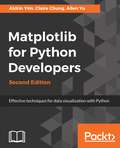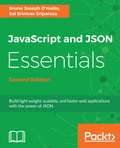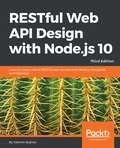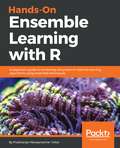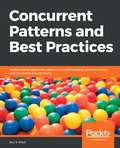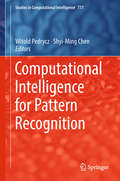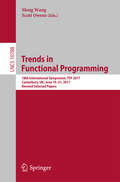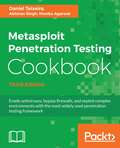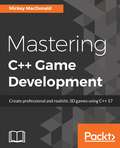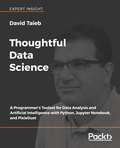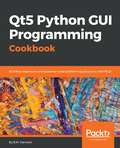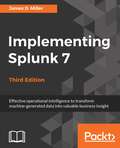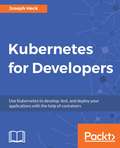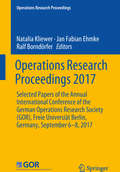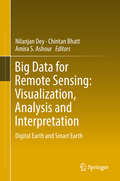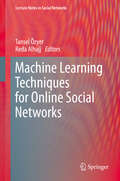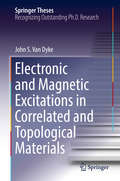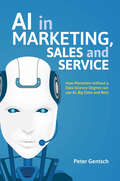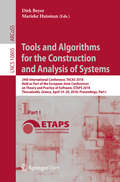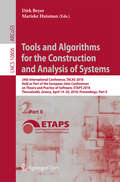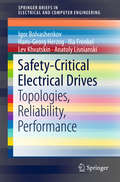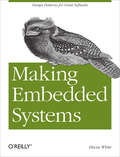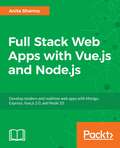- Table View
- List View
Matplotlib for Python Developers: Effective techniques for data visualization with Python, 2nd Edition
by Allen Yu Claire Chung Aldrin YimLeverage the power of Matplotlib to visualize and understand your data more effectivelyKey FeaturesPerform effective data visualization with Matplotlib and get actionable insights from your dataDesign attractive graphs, charts, and 2D plots, and deploy them to the webGet the most out of Matplotlib in this practical guide with updated code and examplesBook DescriptionPython is a general-purpose programming language increasingly being used for data analysis and visualization. Matplotlib is a popular data visualization package in Python used to design effective plots and graphs. This is a practical, hands-on resource to help you visualize data with Python using the Matplotlib library. Matplotlib for Python Developers, Second Edition shows you how to create attractive graphs, charts, and plots using Matplotlib. You will also get a quick introduction to third-party packages, Seaborn, Pandas, Basemap, and Geopandas, and learn how to use them with Matplotlib. After that, you’ll embed and customize your plots in third-party tools such as GTK+3, Qt 5, and wxWidgets. You’ll also be able to tweak the look and feel of your visualization with the help of practical examples provided in this book. Further on, you’ll explore Matplotlib 2.1.x on the web, from a cloud-based platform using third-party packages such as Django. Finally, you will integrate interactive, real-time visualization techniques into your current workflow with the help of practical real-world examples.By the end of this book, you’ll be thoroughly comfortable with using the popular Python data visualization library Matplotlib 2.1.x and leveraging its power to build attractive, insightful, and powerful visualizations.What you will learnCreate 2D and 3D static plots such as bar charts, heat maps, and scatter plotsGet acquainted with GTK+3, Qt5, and wxWidgets to understand the UI backend of MatplotlibDevelop advanced static plots with third-party packages such as Pandas, GeoPandas, and SeabornCreate interactive plots with real-time updatesDevelop web-based, Matplotlib-powered graph visualizations with third-party packages such as DjangoWrite data visualization code that is readily expandable on the cloud platformWho this book is forThis book is essentially for anyone who wants to create intuitive data visualizations using the Matplotlib library. If you’re a data scientist or analyst and wish to create attractive visualizations using Python, you’ll find this book useful. Some knowledge of Python programming is all you need to get started.
JavaScript and JSON Essentials: Build light weight, scalable, and faster web applications with the power of JSON, 2nd Edition
by Sai S Sriparasa Bruno DmelloUse JSON for building web applications with technologies like HTML, JavaScript, Angular, Node.js, Hapi.js, Kafka, socket.io, MongoDB, Gulp.js, and handlebar.js, and others formats like GEOJSON, JSON-LD, MessagePack, and BSON.Key FeaturesUse JSON with trending technologies like Angular, Hapi.js, MongoDB, Kafka, and Socket.ioDebug, validate, and format JSON using developer toolkits, JSONLint, and JSON Editor OnlineExplore other JSON formats like GeoJSON, JSON-LD, BSON, and MessagePackBook DescriptionJSON is an established and standard format used to exchange data. This book shows how JSON plays different roles in full web development through examples. By the end of this book, you'll have a new perspective on providing solutions for your applications and handling their complexities.After establishing a strong basic foundation with JSON, you'll learn to build frontend apps by creating a carousel. Next, you'll learn to implement JSON with Angular 5, Node.js, template embedding, and composer.json in PHP. This book will also help you implement Hapi.js (known for its JSON-configurable architecture) for server-side scripting.You'll learn to implement JSON for real-time apps using Kafka, as well as how to implement JSON for a task runner, and for MongoDB BSON storage. The book ends with some case studies on JSON formats to help you sharpen your creativity by exploring futuristic JSON implementations. By the end of the book, you'll be up and running with all the essential features of JSON and JavaScript and able to build fast, scalable, and efficient web applications.What you will learnUse JSON to store metadata for dependency managers, package managers, configuration managers, and metadata storesHandle asynchronous behavior in applications using callbacks, promises, generators, and async-await functionsUse JSON for Angular 5, Node.js, Gulp.js, and Hapi.jsImplement JSON as BSON in MongoDBMake use of JSON in developing automation scriptsImplement JSON for realtime using socket.io and distributed systems using KafkaWho this book is forIf you’re a web developer with a basic understanding of JavaScript and want to write JSON data, integrate it with RESTful APIs to create faster and scalable applications, this book is for you.
RESTful Web API Design with Node.js 10, Third Edition: Learn to create robust RESTful web services with Node.js, MongoDB, and Express.js, 3rd Edition
by Valentin BojinovDesign and implement scalable and maintainable RESTful solutions with Node.js 10Key FeaturesCreate rich and scalable RESTful API solutions from scratchExplore the new features of Node.js 10, Express 4.0, and MongoDBIntegrate MongoDB in your Node.js application to store and secure your dataBook DescriptionWhen building RESTful services, it is really important to choose the right framework. Node.js, with its asynchronous, event-driven architecture, is exactly the right choice for building RESTful APIs.This third edition of RESTful Web API Design with Node.js 10 will teach you to create scalable and rich RESTful applications based on the Node.js platform. You will be introduced to the latest NPM package handler and understand how to use it to customize your RESTful development process. You will begin by understanding the key principle that makes an HTTP application a RESTful-enabled application. After writing a simple HTTP request handler, you will create and test Node.js modules using automated tests and mock objects; explore using the NoSQL database, MongoDB, to store data; and get to grips with using self-descriptive URLs. You’ll learn to set accurate HTTP status codes along with understanding how to keep your applications backward-compatible. Also, while implementing a full-fledged RESTful service, you will use Swagger to document the API and implement automation tests for a REST-enabled endpoint with Mocha. Lastly, you will explore some authentication techniques to secure your application. What you will learn Install, develop, and test your own Node.js user modulesUnderstand the differences between HTTP and RESTful applicationsUse self-descriptive URLs and set accurate HTTP status codesEliminate third-party dependencies in your tests with mockingImplement automation tests for a REST-enabled endpoint with MochaSecure your services with NoSQL database integration within Node.js applications Integrate a simple frontend using JavaScript libraries available on a CDN serverWho this book is forIf you are a web developer keen to enrich your development skills to create server-side RESTful applications based on the Node.js platform, this book is for you. Some knowledge of REST would be an added advantage, but is definitely not a necessity.
Hands-On Ensemble Learning with R: A beginner's guide to combining the power of machine learning algorithms using ensemble techniques
by Prabhanjan Narayanachar TattarExplore powerful R packages to create predictive models using ensemble methodsKey FeaturesImplement machine learning algorithms to build ensemble-efficient modelsExplore powerful R packages to create predictive models using ensemble methodsLearn to build ensemble models on large datasets using a practical approachBook DescriptionEnsemble techniques are used for combining two or more similar or dissimilar machine learning algorithms to create a stronger model. Such a model delivers superior prediction power and can give your datasets a boost in accuracy.Hands-On Ensemble Learning with R begins with the important statistical resampling methods. You will then walk through the central trilogy of ensemble techniques – bagging, random forest, and boosting – then you'll learn how they can be used to provide greater accuracy on large datasets using popular R packages. You will learn how to combine model predictions using different machine learning algorithms to build ensemble models. In addition to this, you will explore how to improve the performance of your ensemble models.By the end of this book, you will have learned how machine learning algorithms can be combined to reduce common problems and build simple efficient ensemble models with the help of real-world examples.What you will learnCarry out an essential review of re-sampling methods, bootstrap, and jackknifeExplore the key ensemble methods: bagging, random forests, and boostingUse multiple algorithms to make strong predictive modelsEnjoy a comprehensive treatment of boosting methodsSupplement methods with statistical tests, such as ROCWalk through data structures in classification, regression, survival, and time series dataUse the supplied R code to implement ensemble methodsLearn stacking method to combine heterogeneous machine learning modelsWho this book is forThis book is for you if you are a data scientist or machine learning developer who wants to implement machine learning techniques by building ensemble models with the power of R. You will learn how to combine different machine learning algorithms to perform efficient data processing. Basic knowledge of machine learning techniques and programming knowledge of R would be an added advantage.
Concurrent Patterns and Best Practices: Build scalable apps with patterns in multithreading, synchronization, and functional programming
by Atul S. KhotA definitive guide to mastering and implementing concurrency patterns in your applicationsKey FeaturesBuild scalable apps with patterns in multithreading, synchronization, and functional programmingExplore the parallel programming and multithreading techniques to make the code run fasterEfficiently use the techniques outlined to build reliable applicationsBook DescriptionSelecting the correct concurrency architecture has a significant impact on the design and performance of your applications. This book explains how to leverage the different characteristics of parallel architecture to make your code faster and more efficient. To start with, you'll understand the basic concurrency concepts and explore patterns around explicit locking, lock free programming, futures & actors. Then, you'll get insights into different concurrency models and parallel algorithms and put them to practice in different scenarios to realize your application's true potential. We'll take you through multithreading design patterns, such as master, slave, leader, follower, map-reduce, and monitor, also helping you to learn hands-on coding using these patterns. Once you've grasped all of this, you'll move on to solving problems using synchronizer patterns. You'll discover the rationale for these patterns in distributed & parallel applications, followed by studying how future composition, immutability and the monadic flow help create more robust code. Toward the end of the book, you'll learn about the actor paradigm and actor patterns - the message passing concurrency paradigm.What you will learnExplore parallel architecture Get acquainted with concurrency models Internalize design themes by implementing multithreading patterns Get insights into concurrent design patterns Discover design principles behind many java threading abstractions Work with functional concurrency patternsWho this book is forThis is a must-have guide for developers who want to learn patterns to build scalable and high-performing apps. It’s assumed that you already have a decent level of programming knowledge.
Computational Intelligence for Pattern Recognition (Studies In Computational Intelligence #777)
by Witold Pedrycz Shyi-Ming ChenThe book presents a comprehensive and up-to-date review of fuzzy pattern recognition. It carefully discusses a range of methodological and algorithmic issues, as well as implementations and case studies, and identifies the best design practices, assesses business models and practices of pattern recognition in real-world applications in industry, health care, administration, and business. Since the inception of fuzzy sets, fuzzy pattern recognition with its methodology, algorithms, and applications, has offered new insights into the principles and practice of pattern classification. Computational intelligence (CI) establishes a comprehensive framework aimed at fostering the paradigm of pattern recognition. The collection of contributions included in this book offers a representative overview of the advances in the area, with timely, in-depth and comprehensive material on the conceptually appealing and practically sound methodology and practices of CI-based pattern recognition.
Trends in Functional Programming: 18th International Symposium, Tfp 2017, Canterbury, Uk, June 19-21, 2017, Revised Selected Papers (Lecture Notes In Computer Science #10788)
by Meng Wang Scott OwensThis book constitutes the thoroughly refereed revised selected papers of the 18th International Symposium on Trends in Functional Programming, TFP 2017, held in Canterbury, UK, in June 2017. The 8 revised full papers were selected from 16 submissions and present papers in all aspects of functional programming, taking a broad view of current and future trends in the area.
Metasploit Penetration Testing Cookbook: Evade antiviruses, bypass firewalls, and exploit complex environments with the most widely used penetration testing framework, 3rd Edition
by Abhinav Singh Monika Agarwal Nipun Jaswal Daniel TeixeiraOver 100 recipes for penetration testing using Metasploit and virtual machines Key Features Special focus on the latest operating systems, exploits, and penetration testing techniques Learn new anti-virus evasion techniques and use Metasploit to evade countermeasures Automate post exploitation with AutoRunScript Exploit Android devices, record audio and video, send and read SMS, read call logs, and much more Build and analyze Metasploit modules in Ruby Integrate Metasploit with other penetration testing tools Book Description Metasploit is the world's leading penetration testing tool and helps security and IT professionals find, exploit, and validate vulnerabilities. Metasploit allows penetration testing automation, password auditing, web application scanning, social engineering, post exploitation, evidence collection, and reporting. Metasploit's integration with InsightVM (or Nexpose), Nessus, OpenVas, and other vulnerability scanners provides a validation solution that simplifies vulnerability prioritization and remediation reporting. Teams can collaborate in Metasploit and present their findings in consolidated reports. In this book, you will go through great recipes that will allow you to start using Metasploit effectively. With an ever increasing level of complexity, and covering everything from the fundamentals to more advanced features in Metasploit, this book is not just for beginners but also for professionals keen to master this awesome tool. You will begin by building your lab environment, setting up Metasploit, and learning how to perform intelligence gathering, threat modeling, vulnerability analysis, exploitation, and post exploitation—all inside Metasploit. You will learn how to create and customize payloads to evade anti-virus software and bypass an organization's defenses, exploit server vulnerabilities, attack client systems, compromise mobile phones, automate post exploitation, install backdoors, run keyloggers, highjack webcams, port public exploits to the framework, create your own modules, and much more. What you will learn Set up a complete penetration testing environment using Metasploit and virtual machines Master the world's leading penetration testing tool and use it in professional penetration testing Make the most of Metasploit with PostgreSQL, importing scan results, using workspaces, hosts, loot, notes, services, vulnerabilities, and exploit results Use Metasploit with the Penetration Testing Execution Standard methodology Use MSFvenom efficiently to generate payloads and backdoor files, and create shellcode Leverage Metasploit's advanced options, upgrade sessions, use proxies, use Meterpreter sleep control, and change timeouts to be stealthy Who this book is for If you are a Security professional or pentester and want to get into vulnerability exploitation and make the most of the Metasploit framework, then this book is for you. Some prior understanding of penetration testing and Metasploit is required.
Mastering C++ Game Development: Create professional and realistic 3D games using C++ 17
by Mickey MacdonaldHigh-end game development with advanced C++ 17 programming techniques Key Features Make the best use of object-oriented capabilities of C++ 17 to develop high-end games Create reusable C++ 17 libraries and editor tools for your game Series of example projects demonstrating advanced techniques to build games of any genre Book Description Although many languages are now being used to develop games, C++ remains the standard for professional development. The majority of professional libraries and toolchains are still built using C++. The primary goal of this book is to teach you how to harness the power of the language and provide you with the ability to build high-quality games. To begin, you will be presented with, an overview of popular development methodologies, and a short guide to updated features of the C++ 17 standard. You will learn how to leverage existing libraries such as OpenGL and the STL (standard library) to build complex systems. Throughout the journey, you will also build a set of C++ 17 compatible libraries that can be reused in your own development projects. In the last half of the book, you will work with demos designed to introduce you to advanced rendering techniques, interactive physics, advanced AI techniques, and even multiplayer game concerns with modern networks. What you will learn Work and communicate effectively in the modern games industry Develop simple and advanced gameplay systems How to leverage the standard core C++ libraries Use modern real-time rendering techniques to achieve immersive 3D visuals Achieve a narrative-driven game experience using a variety of data management techniques Implement scripting using LUA Learn AI algorithms and concepts for handling motion, behavior, and decision making Implementation of the OpenGL, Bullet Physics, GLM, SteamVR and other common libraries Who this book is for This book is intended for aspiring game developers who are proficient in C++ 17 programming and are interested in developing professional games with C++.17
Thoughtful Data Science: A Programmer’s Toolset for Data Analysis and Artificial Intelligence with Python, Jupyter Notebook, and PixieDust
by David TaiebBridge the gap between developer and data scientist by creating a modern open-source, Python-based toolset that works with Jupyter Notebook, and PixieDust.Key FeaturesThink deeply as a developer about your strategy and toolset in data science Discover the best tools that will suit you as a developer in your data analysis Accelerate the road to data insight as a programmer using Jupyter NotebookDeep dive into multiple industry data science use cases Book DescriptionThoughtful Data Science brings new strategies and a carefully crafted programmer's toolset to work with modern, cutting-edge data analysis. This new approach is designed specifically to give developers more efficiency and power to create cutting-edge data analysis and artificial intelligence insights.Industry expert David Taieb bridges the gap between developers and data scientists by creating a modern open-source, Python-based toolset that works with Jupyter Notebook, and PixieDust. You'll find the right balance of strategic thinking and practical projects throughout this book, with extensive code files and Jupyter projects that you can integrate with your own data analysis.David Taieb introduces four projects designed to connect developers to important industry use cases in data science. The first is an image recognition application with TensorFlow, to meet the growing importance of AI in data analysis. The second analyses social media trends to explore big data issues and natural language processing. The third is a financial portfolio analysis application using time series analysis, pivotal in many data science applications today. The fourth involves applying graph algorithms to solve data problems. Taieb wraps up with a deep look into the future of data science for developers and his views on AI for data science.What you will learnBridge the gap between developer and data scientist with a Python-based toolsetGet the most out of Jupyter Notebooks with new productivity-enhancing tools Explore and visualize data using Jupyter Notebooks and PixieDust Work with and assess the impact of artificial intelligence in data science Work with TensorFlow, graphs, natural language processing, and time seriesDeep dive into multiple industry data science use cases Look into the future of data analysis and where to develop your skillsWho this book is forThis book is for established developers who want to bridge the gap between programmers and data scientists. With the introduction of PixieDust from its creator, the book will also be a great desk companion for the already accomplished Data Scientist. Some fluency in data interpretation and visualization is also assumed since this book addresses data professionals such as business and general data analysts. It will be helpful to have some knowledge of Python, using Python libraries, and some proficiency in web development.
Qt5 Python GUI Programming Cookbook: Building responsive and powerful cross-platform applications with PyQt
by B. M. HarwaniOver 60 recipes to help you design interactive, smart, and cross-platform GUI applicationsKey Features Get succinct QT solutions to pressing GUI programming problems in Python Learn how to effectively implement reactive programming Build customized applications that are robust and reliableBook DescriptionPyQt is one of the best cross-platform interface toolkits currently available; it's stable, mature, and completely native. If you want control over all aspects of UI elements, PyQt is what you need. This book will guide you through every concept necessary to create fully functional GUI applications using PyQt, with only a few lines of code.As you expand your GUI using more widgets, you will cover networks, databases, and graphical libraries that greatly enhance its functionality. Next, the book guides you in using Qt Designer to design user interfaces and implementing and testing dialogs, events, the clipboard, and drag and drop functionality to customize your GUI. You will learn a variety of topics, such as look and feel customization, GUI animation, graphics rendering, implementing Google Maps, and more. Lastly, the book takes you through how Qt5 can help you to create cross-platform apps that are compatible with Android and iOS. You will be able to develop functional and appealing software using PyQt through interesting and fun recipes that will expand your knowledge of GUIsWhat you will learn Use basic Qt components, such as a radio button, combo box, and sliders Use QSpinBox and sliders to handle different signals generated on mouse clicks Work with different Qt layouts to meet user interface requirements Create custom widgets and set up customizations in your GUI Perform asynchronous I/O operations and thread handling in the Python GUI Employ network concepts, internet browsing, and Google Maps in UI Use graphics rendering and implement animation in your GUI Make your GUI application compatible with Android and iOS devicesWho this book is forIf you’re an intermediate Python programmer wishing to enhance your coding skills by writing powerful GUIs in Python using PyQT, this is the book for you.
The Twitter Book (O'reilly Ser.)
by Tim O'Reilly Sarah MilsteinTwitter is not just for talking about your breakfast anymore. It's become an indispensable communications tool for businesses, non-profits, celebrities, and people around the globe. With the second edition of this friendly, full-color guide, you'll quickly get up to speed not only on standard features, but also on new options and nuanced uses that will help you tweet with confidence. Co-written by two widely recognized Twitter experts, The Twitter Book is packed with all-new real-world examples, solid advice, and clear explanations guaranteed to turn you into a power user. Use Twitter to connect with colleagues, customers, family, and friends Stand out on Twitter Avoid common gaffes and pitfalls Build a critical communications channel with Twitter--and use the best third-party tools to manage it. Want to learn how to use Twitter like a pro? Get the book that readers and critics alike rave about.
Implementing Splunk 7, Third Edition: Effective operational intelligence to transform machine-generated data into valuable business insight, 3rd Edition
by James D. MillerA comprehensive guide to making machine data accessible across the organization using advanced dashboards Key FeaturesEnrich machine-generated data and transform it into useful, meaningful insightsPerform search operations and configurations, build dashboards, and manage logsExtend Splunk services with scripts and advanced configurations to process optimal resultsBook DescriptionSplunk is the leading platform that fosters an efficient methodology and delivers ways to search, monitor, and analyze growing amounts of big data. This book will allow you to implement new services and utilize them to quickly and efficiently process machine-generated big data. We introduce you to all the new features, improvements, and offerings of Splunk 7. We cover the new modules of Splunk: Splunk Cloud and the Machine Learning Toolkit to ease data usage. Furthermore, you will learn to use search terms effectively with Boolean and grouping operators. You will learn not only how to modify your search to make your searches fast but also how to use wildcards efficiently. Later you will learn how to use stats to aggregate values, a chart to turn data, and a time chart to show values over time; you'll also work with fields and chart enhancements and learn how to create a data model with faster data model acceleration. Once this is done, you will learn about XML Dashboards, working with apps, building advanced dashboards, configuring and extending Splunk, advanced deployments, and more. Finally, we teach you how to use the Machine Learning Toolkit and best practices and tips to help you implement Splunk services effectively and efficiently. By the end of this book, you will have learned about the Splunk software as a whole and implemented Splunk services in your tasks at projectsWhat you will learnFocus on the new features of the latest version of Splunk Enterprise 7Master the new offerings in Splunk: Splunk Cloud and the Machine Learning ToolkitCreate efficient and effective searches within the organizationMaster the use of Splunk tables, charts, and graph enhancementsUse Splunk data models and pivots with faster data model accelerationMaster all aspects of Splunk XML dashboards with hands-onapplicationsCreate and deploy advanced Splunk dashboards to share valuable business insights with peers Who this book is forThis book is intended for data analysts, business analysts, and IT administrators who want to make the best use of big data, operational intelligence, log management, and monitoring within their organization. Some knowledge of Splunk services will help you get the most out of the book
Kubernetes for Developers: Use Kubernetes to develop, test, and deploy your applications with the help of containers
by Joseph HeckA developer's field-guide to designing scalable services using KubernetesKey FeaturesDevelop and run your software using containers within a Kubernetes environmentGet hands-on experience of using Kubernetes with DevOps concepts such as continuous integration, benchmark testing, monitoring, and so onPragmatic example-based approach showing how to use Kubernetes in the development processBook DescriptionKubernetes is documented and typically approached from the perspective of someone running software that has already been built. Kubernetes may also be used to enhance the development process, enabling more consistent testing and analysis of code to help developers verify not only its correctness, but also its efficiency. This book introduces key Kubernetes concepts, coupled with examples of how to deploy and use them with a bit of Node.js and Python example code, so that you can quickly replicate and use that knowledge.You will begin by setting up Kubernetes to help you develop and package your code. We walk you through the setup and installation process before working with Kubernetes in the development environment. We then delve into concepts such as automating your build process, autonomic computing, debugging, and integration testing. This book covers all the concepts required for a developer to work with Kubernetes.By the end of this book, you will be in a position to use Kubernetes in developmentecosystems.What you will learn Build your software into containers Deploy and debug software running in containers within Kubernetes Declare and add configuration through Kubernetes Define how your application fits together, using internal and external services Add feedback to your code to help Kubernetes manage your services Monitor and measure your services through integration testing and in production deploymentsWho this book is forIf you are a full-stack or back-end software developers interested, curious, or being asked to test as well as run the code you're creating, you can leverage Kubernetes to make that process simpler and consistent regardless of where you deploy. If you're looking for developer focused examples in NodeJS and Python for how to build, test, deploy, and run your code with Kubernetes, this is perfect for you.
Operations Research Proceedings 2017: Selected Papers Of The Annual International Conference Of The German Operations Research Society (gor), Freie Universiät Berlin, Germany, September 6-8 2017 (Operations Research Proceedings Ser.)
by Jan Fabian Ehmke Ralf Borndörfer Natalia KliewerThis book gathers a selection of peer-reviewed papers presented at the International Conference on Operations Research (OR 2017), which was held at Freie Universität Berlin, Germany on September 6-8, 2017. More than 800 scientists, practitioners and students from mathematics, computer science, business/economics and related fields attended the conference and presented more than 500 papers in parallel topic streams, as well as special award sessions. The main theme of the conference and its proceedings was "Decision Analytics for the Digital Economy."
Big Data for Remote Sensing: Digital Earth And Smart Earth
by Nilanjan Dey Chintan Bhatt Amira S. AshourThis book thoroughly covers the remote sensing visualization and analysis techniques based on computational imaging and vision in Earth science. Remote sensing is considered a significant information source for monitoring and mapping natural and man-made land through the development of sensor resolutions that committed different Earth observation platforms. The book includes related topics for the different systems, models, and approaches used in the visualization of remote sensing images. It offers flexible and sophisticated solutions for removing uncertainty from the satellite data. It introduces real time big data analytics to derive intelligence systems in enterprise earth science applications. Furthermore, the book integrates statistical concepts with computer-based geographic information systems (GIS). It focuses on image processing techniques for observing data together with uncertainty information raised by spectral, spatial, and positional accuracy of GPS data. The book addresses several advanced improvement models to guide the engineers in developing different remote sensing visualization and analysis schemes. Highlights on the advanced improvement models of the supervised/unsupervised classification algorithms, support vector machines, artificial neural networks, fuzzy logic, decision-making algorithms, and Time Series Model and Forecasting are addressed. This book guides engineers, designers, and researchers to exploit the intrinsic design remote sensing systems. The book gathers remarkable material from an international experts' panel to guide the readers during the development of earth big data analytics and their challenges.
Machine Learning Techniques for Online Social Networks (Lecture Notes In Social Networks Ser.)
by Tansel Özyer Reda AlhajjThe book covers tools in the study of online social networks such as machine learning techniques, clustering, and deep learning. A variety of theoretical aspects, application domains, and case studies for analyzing social network data are covered. The aim is to provide new perspectives on utilizing machine learning and related scientific methods and techniques for social network analysis. Machine Learning Techniques for Online Social Networks will appeal to researchers and students in these fields.
Electronic and Magnetic Excitations in Correlated and Topological Materials (Springer Theses)
by John S. Van DykeThis thesis reports a major breakthrough in discovering the superconducting mechanism in CeCoIn5, the “hydrogen atom” among heavy fermion compounds. By developing a novel theoretical formalism, the study described herein succeeded in extracting the crucial missing element of superconducting pairing interaction from scanning tunneling spectroscopy experiments. This breakthrough provides a theoretical explanation for a series of puzzling experimental observations, demonstrating that strong magnetic interactions provide the quantum glue for unconventional superconductivity. Additional insight into the complex properties of strongly correlated and topological materials was provided by investigating their non-equilibrium charge and spin transport properties. The findings demonstrate that the interplay of magnetism and disorder with strong correlations or topology leads to complex and novel behavior that can be exploited to create the next generation of spin electronics and quantum computing devices.
AI in Marketing, Sales and Service: How Marketers without a Data Science Degree can use AI, Big Data and Bots
by Peter GentschAI and Algorithmics have already optimized and automated production and logistics processes. Now it is time to unleash AI on the administrative, planning and even creative procedures in marketing, sales and management.This book provides an easy-to-understand guide to assessing the value and potential of AI and Algorithmics. It systematically draws together the technologies and methods of AI with clear business scenarios on an entrepreneurial level. With interviews and case studies from those cutting edge businesses and executives who are already leading the way, this book shows you: how customer and market potential can be automatically identified and profiled; how media planning can be intelligently automated and optimized with AI and Big Data; how (chat)bots and digital assistants can make communication between companies and consumers more efficient and smarter; how you can optimize Customer Journeys based on Algorithmics and AI; and how to conduct market research in more efficient and smarter way. A decade from now, all businesses will be AI businesses – Gentsch shows you how to make sure yours makes that transition better than your competitors.
Tools and Algorithms for the Construction and Analysis of Systems: 24th International Conference, Tacas 2018, Held As Part Of The European Joint Conferences On Theory And Practice Of Software, Etaps 2018, Thessaloniki, Greece, April 14-20, 2018. Proceedings, Part I (Lecture Notes in Computer Science #10805)
by Marieke Huisman Dirk BeyerThis book is Open Access under a CC BY licence. The LNCS 10805 and 10806 proceedings set constitutes the proceedings of the 24th International Conference on Tools and Algorithms for the Construction and Analysis of Systems, TACAS 2018, which took place in Thessaloniki, Greece, in April 2018, held as part of the European Joint Conference on Theory and Practice of Software, ETAPS 2018. The total of 43 full and 11 short papers presented in these volumes was carefully reviewed and selected from 154submissions. The papers are organized in topical sections as follows: Part I: theorem proving; SAT and SMT I; deductive verification; software verification and optimization; model checking; and machine learning. Part II: concurrent and distributed systems; SAT and SMT II; security and reactive systems; static and dynamic program analysis; hybrid and stochastic systems; temporal logic and mu-calculus; 7th Competition on Software Verification – SV-COMP.
Tools and Algorithms for the Construction and Analysis of Systems: 24th International Conference, Tacas 2018, Held As Part Of The European Joint Conferences On Theory And Practice Of Software, Etaps 2018, Thessaloniki, Greece, April 14-20, 2018. Proceedings, Part I (Lecture Notes in Computer Science #10805)
by Marieke Huisman Dirk BeyerThis book is Open Access under a CC BY licence.The LNCS 10805 and 10806 proceedings set constitutes the proceedings of the 24th International Conference on Tools and Algorithms for the Construction and Analysis of Systems, TACAS 2018, which took place in Thessaloniki, Greece, in April 2018, held as part of the European Joint Conference on Theory and Practice of Software, ETAPS 2018.The total of 43 full and 11 short papers presented in these volumes was carefully reviewed and selected from 154submissions. The papers are organized in topical sections as follows:Part I: theorem proving; SAT and SMT I; deductive verification; software verification and optimization; model checking; and machine learning. Part II: concurrent and distributed systems; SAT and SMT II; security and reactive systems; static and dynamic program analysis; hybrid and stochastic systems; temporal logic and mu-calculus; 7th Competition on Software Verification – SV-COMP.
Safety-Critical Electrical Drives: Topologies, Reliability, Performance (SpringerBriefs in Electrical and Computer Engineering)
by Ilia Frenkel Anatoly Lisnianski Igor Bolvashenkov Hans-Georg Herzog Lev KhvatskinThis book focuses on one of the most important aspects of electrical propulsion systems – the creation of highly reliable safety-critical traction electrical drives. It discusses the methods and models for analysis and optimization of reliability and fault tolerance indices, based on which, it proposes and assesses methods for improving the availability, fault tolerance and performance of traction electric drives.
Making Embedded Systems: Design Patterns for Great Software
by Elecia WhiteInterested in developing embedded systems? Since they don't tolerate inefficiency, these systems require a disciplined approach to programming. This easy-to-read guide helps you cultivate a host of good development practices, based on classic software design patterns and new patterns unique to embedded programming. Learn how to build system architecture for processors, not operating systems, and discover specific techniques for dealing with hardware difficulties and manufacturing requirements. Written by an expert who's created embedded systems ranging from urban surveillance and DNA scanners to children's toys, this book is ideal for intermediate and experienced programmers, no matter what platform you use. Optimize your system to reduce cost and increase performance Develop an architecture that makes your software robust in resource-constrained environments Explore sensors, motors, and other I/O devices Do more with less: reduce RAM consumption, code space, processor cycles, and power consumption Learn how to update embedded code directly in the processor Discover how to implement complex mathematics on small processors Understand what interviewers look for when you apply for an embedded systems job "Making Embedded Systems is the book for a C programmer who wants to enter the fun (and lucrative) world of embedded systems. It's very well written--entertaining, even--and filled with clear illustrations." --Jack Ganssle, author and embedded system expert.
Full-Stack Web Development with Vue.js and Node: Build scalable and powerful web apps with modern web stack: MongoDB, Vue, Node.js, and Express
by Aneeta SharmaBring the frontend and backend together with Vue, Vuex, and Node.jsKey FeaturesConstruct modern web applications with Node 10, Express.js, MongoDB, and VueLeverage the latest web standards to increase code performance, readability, and cross-compatibilityHarness the power of the JavaScript ecosystem to effectively run, build, and test your full stack applicationsBook DescriptionIsomorphic JavaScript was the buzzword of the year 2017, allowing developers to utilize a single language throughout their web development stack and build cost-effective and scalable applications. MEVN is a one such modern web development stack consisting of web applications such as MongoDB, Express.js, Vue.js, and Node.js. Hands-On Full-Stack Web Development with Vue.js 2 and Node.js leverages the harmony of these technologies to help you create full-stack web applications.Starting with the core frameworks, this example-based guide explains all the key concepts of frameworks, how to set them up properly, and how to use popular modules to connect them together and make them work cohesively. You will learn all this with the help of real-world examples. In addition to this, you will be able to scaffold web application architecture, add an authentication layer, and develop the MVC structure to support the development of your application. You'll explore how to create data models for your applications and then write REST APIs by exposing your data model to your application. Solely orientated towards building a full, end-to-end application using the MEVN stack, this book will help you understand how your application development grows.What you will learnBuild an application with Express.jsCreate schemas using MongooseDevelop a single-page application using Vue.js and Express.jsCreate RESTful APIs using Express.jsAdd test cases to improve the reliability of the applicationLearn how to deploy apps on Heroku using GitHubAdd authorization using passportsWho this book is forIf you are a web or a full-stack JavaScript developer, and have tried your hand at traditional stacks such as LAMP, MEAN or MERN, or wish to explore a new stack with modern web technologies, then this book is for you. Prior knowledge of HTML, CSS, and JavaScript would be an added advantage.
Mastering Arduino: A project-based approach to electronics, circuits, and programming
by Jon HoffmanMastering Arduino is a practical, no-nonsense guide that will teach you the electronics and programming skills that you need to create advanced Arduino projects.Key FeaturesCovers enough electronics and code for users at any levelIncludes complete circuit diagrams for all projectsFinal robot project combines knowledge from all the chaptersBook DescriptionMastering Arduino is an all-in-one guide to getting the most out of your Arduino. This practical, no-nonsense guide teaches you all of the electronics and programming skills that you need to create advanced Arduino projects. This book is packed full of real-world projects for you to practice on, bringing all of the knowledge in the book together and giving you the skills to build your own robot from the examples in this book. The final two chapters discuss wireless technologies and how they can be used in your projects. The book begins with the basics of electronics, making sure that you understand components, circuits, and prototyping before moving on. It then performs the same function for code, getting you into the Arduino IDE and showing you how to connect the Arduino to a computer and run simple projects on your Arduino.Once the basics are out of the way, the next 10 chapters of the book focus on small projects centered around particular components, such as LCD displays, stepper motors, or voice synthesizers. Each of these chapters will get you familiar with the technology involved, how to build with it, how to program it, and how it can be used in your own projects. What you will learnExplains the basics of electronics and circuits along with the Arduino IDE and basic C operationsUse sensors to build a mini weather stationControl LEDs using codePower a robot arm using stepper motorsRemotely control your Arduino using RF, Bluetooth LE, and Bluetooth ClassicMake a sound tone generator with buttonsWho this book is forMastering Arduino is for anybody who wants to experiment with an Arduino board and build simple projects. No prior knowledge is required, as the fundamentals of electronics and coding are covered in this book as well as advance projects.
